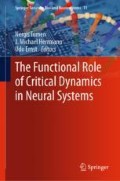Abstract
The Potts associative memory can be regarded as a model of extended cortical networks characterized, near a critical line, by spontaneous latching dynamics, i.e. the unguided hopping from one attractor to the next. Can Potts dynamics also be guided, and follow specific instructed transitions between attractors? In this paper, we study to what extent instructions, given via an additional hetero-associative learning rule, determine latching sequences in an adaptive Potts neural network. Each global activity pattern is both stored as an attractor and associated with a certain strength \(\lambda \) to D randomly generated and a priori selected other patterns. Increasing either the strength \(\lambda \) of hetero-couplings or D leads to longer latching sequences, but also to lower retrieval quality. Further, while the fraction of transitions that follow the instructions initially increases with \(\lambda \), beyond a certain value it drops, the more rapidly the larger D, as spontaneous dynamics ride on top of instructed transitions, taking them off course. This is shown to be due to the (random) instructions not reflecting the structure of correlations among memories, which drives spontaneous dynamics. In fact, when the number of instructed options D is large, the network appears to choose, among them, those with the same correlations as the spontaneous transitions.
Access this chapter
Tax calculation will be finalised at checkout
Purchases are for personal use only
References
Kanter, I.: Potts-glass models of neural networks. Phys. Rev. A 37(7), 2739 (1988)
Bollé, D., Dupont, P., Mourik, J.V.: Stability properties of Potts neural networks with biased patterns and low loading. J. Phy.s A: Math. Gen. 24(5), 1065 (1991)
Bollé, D., Dupont, P., Huyghebaert, J.: Thermodynamic properties of the q-state Potts-glass neural network. Phys. Rev. A 45(6), 4194 (1992)
Bollé, D., Vinck, B., Zagrebnov, V.A.: On the parallel dynamics of the q-state Potts and q-Ising neural networks. J. Stat. Phys. 70(5), 1099–1119 (1993)
Bollé, D., Cools, R., Dupont, P., Huyghebaert, J.: Mean-field theory for the q-state Potts-glass neural network with biased patterns. J Phys A: Math. Gen. 26(3), 549 (1993)
Naim, M., Boboeva, V., Kang, C.J.: Treves A (2018) Reducing a cortical network to a Potts model yields storage capacity estimates. J. Stat. Mech.: Theory Exp. 4, 043304 (2018)
Treves, A.: Frontal latching networks: a possible neural basis for infinite recursion. Cognit. Neuropsychol. 22(3–4), 276–291 (2005)
Kropff, E.: Treves A (2005) the storage capacity of Potts models for semantic memory retrieval. J. Stat. Mech. Theory Exp. 08, P08010 (2005)
Russo, E., Namboodiri, V.M.K., Treves, A., Kropff, E.: Free association transitions in models of cortical latching dynamics. New J. Phys. 10(1), 015008 (2008)
Russo, E., Treves, A.: Cortical free-association dynamics: distinct phases of a latching network. Phys. Rev. E 85(5), 051920 (2012)
Abdollah-nia, M.F., Saeedghalati, M.: Abbassian A (2012) Optimal region of latching activity in an adaptive Potts model for networks of neurons. J. Stat. Mech. Theory Exp. 02, P02018 (2012)
Lerner, I., Bentin, S., Shriki, O.: Spreading activation in an attractor network with latching dynamics: automatic semantic priming revisited. Cognit. Sci. 36(8), 1339–1382 (2012)
Lerner, I., Bentin, S., Shriki, O.: Excessive attractor instability accounts for semantic priming in schizophrenia. PLoS ONE 7(7), e40663 (2012)
Burgess, P.W., Shallice, T.: Confabulation and the control of recollection. Memory 4(4), 359–412 (1996)
Iyer, L.R., Doboli, S., Minai, A.A., Brown, V.R., Levine, D.S., Paulus, P.B.: Neural dynamics of idea generation and the effects of priming. Neural Netw. 22(5), 674–686 (2009)
Shallice, T.: Specific impairments of planning. Philos. Trans. R Soc. Lond. B Biol. Sci. 298(1089), 199–209 (1982)
Kang, C.J., Naim, M., Boboeva, V., Treves, A.: Life on the edge: latching dynamics in a Potts neural network. Entropy 19(9) (2017)
Russo, E., Pirmoradian, S., Treves, A.: Associative latching dynamics vs. syntax. In: Advances in Cognitive Neurodynamics (II), pp. 111–115. Springer, Dordrecht (2011)
Connors, B.W., Malenka, R.C., Silva, L.R.: Two inhibitory postsynaptic potentials, and GABA\(_A\) and GABA\(_B\) receptor-mediated responses in neocortex of rat and cat. J. Physiol. 406(1), 443–468 (1988)
Sompolinsky, H., Kanter, I.: Temporal association in asymmetric neural networks. Phys. Rev. Lett. 57, 2861–2864 (1986)
Hopfield, J.: Neural networks and physical systems with emergent collective computational abilities. Proc. Natl. Acad. Sci. USA 79(8), 2554–2558 (1982)
Amit, D.J.: Modeling Brain Function: The World of Attractor Neural Networks. Cambridge University Press, Cambridge (1992)
Hebb, D.: The Organization of Behavior: A Neuropsychological Theory. Wiley, New York (1949)
Kropff, E., Treves, A.: The complexity of latching transitions in large scale cortical networks. Nat. Comput. 6(2), 169–185 (2007)
Kropff, E.: Full solution for the storage of correlated memories in an autoassociative memory. In: Heinke, D., Mavritsaki, E. (eds.) Computational Modelling in Behavioural Neuroscience: Closing the Gap Between Neurophysiology and Behaviour, 2:225. Psychology Press, USA and Canada (2009)
Acknowledgements
Extensive discussions with several colleagues and in particular with Vezha Boboeva and Michelangelo Naim are gratefully acknowledged, as well as support from Human Frontier Science Program grant RGP0057/2016.
Author information
Authors and Affiliations
Corresponding author
Editor information
Editors and Affiliations
Rights and permissions
Copyright information
© 2019 Springer Nature Switzerland AG
About this chapter
Cite this chapter
Kang, C.J., Treves, A. (2019). The Challenge of Taming a Latching Network Near Criticality. In: Tomen, N., Herrmann, J., Ernst, U. (eds) The Functional Role of Critical Dynamics in Neural Systems . Springer Series on Bio- and Neurosystems, vol 11. Springer, Cham. https://doi.org/10.1007/978-3-030-20965-0_5
Download citation
DOI: https://doi.org/10.1007/978-3-030-20965-0_5
Published:
Publisher Name: Springer, Cham
Print ISBN: 978-3-030-20964-3
Online ISBN: 978-3-030-20965-0
eBook Packages: Biomedical and Life SciencesBiomedical and Life Sciences (R0)

